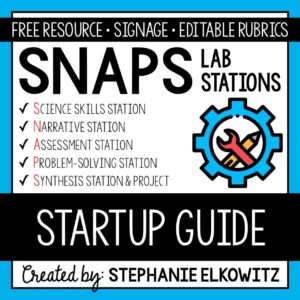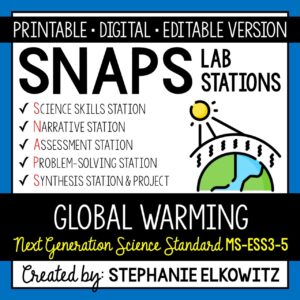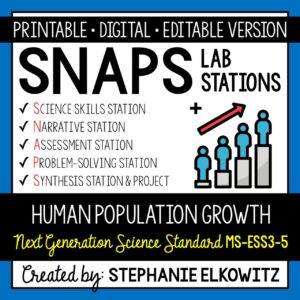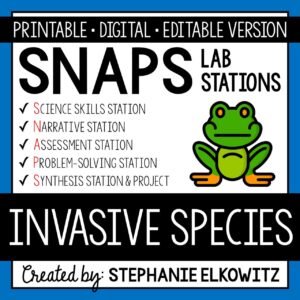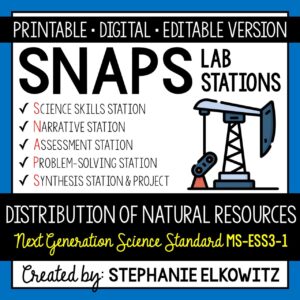MS-PS3-2 Potential Energy Lab
$7.00
An engaging lab activity designed to enhance students’ understanding of the relationship between the position or arrangement of an object (or objects) and potential energy. Aligned with NGSS MS-PS3-2.
Description
MS-PS3-2 Potential Energy Lab Preview
SNAPs Lab Stations Activities require students to use science, math, literacy, problem-solving and engineering skills. They are designed to enhance students’ understanding of scientific concepts and help students apply scientific ideas to the real world. Each station activity promotes skills so to develop students into proficient and competent scientific thinkers.
SNAPs lab activities have five components:
• Science Skills Station to develop science skill proficiency
• Narrative Station to build science literacy
• Assessment Station to evaluate learning and understanding
• Problem-Solving Station to foster engineering design
• Synthesis Station and Project to inspire higher-order learning
DIGITAL LABORATORY – DISTANCE LEARNING & DIGITAL CLASSROOMS
• This lab is offered in a digital format to support digital classrooms & distance learning.
• The digital lab activity is designed to work with Google Slides and Microsoft PowerPoint
• The digital lab activity CANNOT be edited. However:
– Students can manipulate text boxes
– Students can create tables, graphs and diagrams
– Students can insert images and drawings
GOOGLE FORM ASSESSMENT STATION
• The assessment station is offered as a self-grading Google Form.
• Questions are all short answer and are 100% editable.
• Suggestions for use are included in the download.
DISTANCE LEARNING COMPATIBILITY
SNAPs lab activities are rated for their ease with distance – independent learning. Refer to the preview for more information about how well this laboratory works in a fully digital classroom and with distance learning.
EDITABLE DOCUMENTS
This download includes an editable word document (docx file) of all lab components:
• Pre-Lab and Post-Lab Activities
• The Lab Overview
• Lab Station Activities and Questions
• Directed Synthesis Project (when applicable)
Important Notes:
• Diagrams, illustrations, tables and graphs essential to lab activities are included
• Illustrative clipart is NOT included
• Editable documents and rubrics are included with the FREE SNAPs Setup Guide
Editable files allow you to:
• Edit the scope of the activities so to suit your students’ needs
• Edit the materials required based on resource availability
• Create single-period “mini-labs” using activities at the individual skills stations
The activities at each station in this lab are detailed below.
Potential Energy Lab Learning Objectives
1. Describe different types of potential energy.
2. Investigate the position of an object (relative to Earth’s surface) and the (gravitational) potential energy stored in the object.
3. Calculate the gravitational potential energy of an object.
4. Develop a model to describe the relationship between the position or arrangement of an object (or objects) and potential energy.
5. Explain how applying a conservative force to an object (or objects) in a system generates potential energy.
Science Skills Station
Students will conduct an investigation at this station to investigate how distance above Earth’s surface impacts the (gravitational) potential energy of the object. Students will make measurements, calculations and graphs to explain how position impacts the potential energy of an object.
Narrative Station
Students will read a passage about potential energy. Students will also watch a video about how conservative forces (gravitational, spring and electric) can be used to store potential energy in an object.
Assessment Station
At this station, students will answer questions about key terms and ideas about potential energy. Students must employ lower, mid and higher order thinking skills to answer these questions.
Problem-Solving Station
Students will develop models at this station to describe how position affects the potential energy of an object. Specifically, students will model how gravitational, magnetic and electric forces impact the potential energy of a neutral, magnetic and charged object, respectively.
Synthesis Station
Students will compose a CER (claim-evidence-reasoning) report to summarize the lab. Students are provided the claim statement and must support the claim with observations, data and other information gathered in the lab. Students will explain how the evidence supports the claim using scientific reasoning.
Synthesis Project
Students will have a choice of 11 projects. Refer to the SNAPs Lab Stations Best Practices and Setup Guide for directions and suggestions on how to conduct the project.
Directed Synthesis Project
Students can conduct one of the 11 standard synthesis projects, but I strongly suggest using the directed synthesis project to best summarize the information in this lab. Students will design, build and test a catapult or slingshot to launch a marshmallow. Students should design the device so to maximize its ability to store (elastic) potential energy and thus, launch the marshmallow as far as possible. Students will be constrained in time and resources.
This download includes:
• A pre-lab assignment and post-lab reflection
• Directions and questions for each lab station
• Student recording sheets
• Teacher Key
Additional Materials Required:
2 Computers or tablets
Small rubber or bouncy ball
Meter stick
Scale
Calculator
2 Magnets (with poles labeled)
2 Balloons
A piece of wool
Spring (such as from a push-pen)
If performing the directed synthesis project in class you will also need:
Popsicle sticks
Wood dowels or pencils
Spoons
Tin foil
Rubber bands
String
Bottle caps
Tape
Glue
Note: Allow two additional class periods to complete the directed synthesis project in class (if not delegating the project as an at-home assignment)
LINKS TO VIDEOS
This laboratory requires internet to access videos. Videos are hosted on SafeShare.TV so to safely watch and share educational YouTube videos without ads, comments and other distractions. Shortened and full link(s) to SafeShare.TV included. Full link to original YouTube video(s) included.
NEXT GENERATION SCIENCE STANDARDS
This laboratory satisfies NGSS MS-PS3-2. It combines the three dimensions of science learning – science and engineering practices, disciplinary core ideas and crosscutting concepts – to meet the standard. This lab also makes interdisciplinary connections to STEM, Math CCSS and ELA CCSS to build the appropriate skills.
TERMS OF USE
• All rights reserved by Stephanie Elkowitz.
• This product is to be used by the original purchaser only.
• Intended for classroom and personal use only.
• Copying for more than one teacher, classroom, department, school, or school system is prohibited.
• This product may not be distributed or displayed digitally for public view.
• Failure to comply is a copyright infringement and a violation of the Digital Millennium Copyright Act (DMCA).





